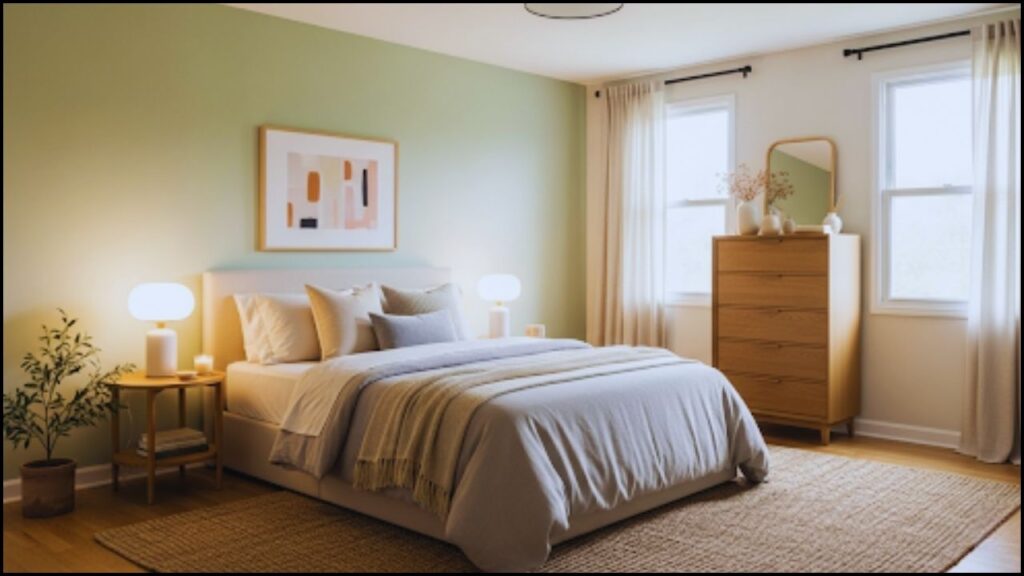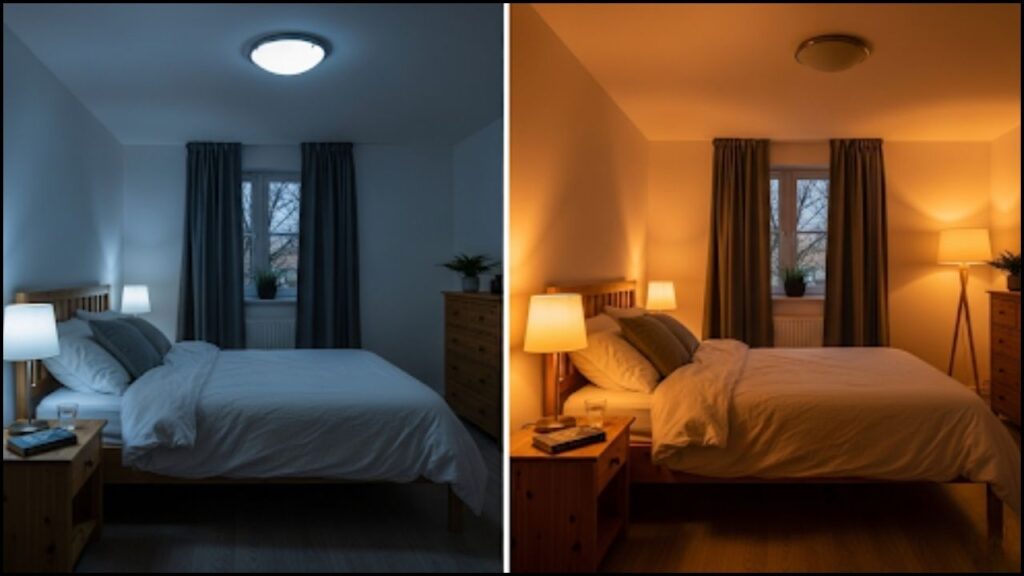The bedroom should be a sanctuary for rest, yet many common design choices actively undermine this goal. Experts in interior design and sleep psychology identify critical bedroom décor mistakes, from improper lighting to excessive clutter, that can increase stress and prevent restorative sleep. Understanding these errors is the first step toward creating a truly relaxing environment.

Key Mistakes and Solutions
| Mistake | Why It Matters | Expert Recommendation |
| 1. Overly Stimulating Colors | Bright, saturated hues can increase alertness and anxiety. | Opt for muted, calming tones like soft blues, greens, or warm neutrals. |
| 2. Harsh or Blue-Toned Lighting | Bright, cool light suppresses melatonin, the sleep hormone. | Use layered, warm-toned lighting (2700K) with dimmers. |
| 3. Visible Clutter | Clutter signals to the brain that work is unfinished, causing stress. | Implement smart storage solutions to keep surfaces clear. |
| 4. Integrated Workstations | Blurs the line between rest and work, preventing mental shutdown. | Relocate work desks to another area of the home if possible. |
| 5. Excessive Technology | Blue light from screens disrupts circadian rhythms; notifications cause anxiety. | Establish a “no-screen” rule at least one hour before bed. |
| 6. Poor Bed Placement | An inward-facing bed can create a subconscious feeling of vulnerability. | Position the bed so you can see the door without being in its direct path. |
| 7. Lack of Texture | A room without varied textures can feel sterile and uninviting. | Layer materials like linen, wool, and velvet in bedding and rugs. |
| 8. Incorrect Furniture Scale | Oversized or undersized furniture can make a room feel unbalanced. | Choose pieces proportional to the room’s dimensions for a sense of harmony. |
The Psychology of a Restful Space
A bedroom’s design has a direct and measurable impact on mental well-being and sleep quality. The environment where individuals spend roughly a third of their lives sends constant signals to the brain. A disorganized, brightly lit, or visually jarring space can contribute to a state of low-grade stress, making it difficult for the mind to transition into a restful state.
“Your bedroom should be the ultimate sanctuary, a place where you can fully disconnect from the demands of the day,” said Dr. Chloe Carmichael, a clinical psychologist based in New York. “When the visual cues in the room are chaotic or stimulating, it keeps your nervous system on high alert, which is the antithesis of what you need for deep sleep.” This sentiment is supported by research, including studies from the Princeton University Neuroscience Institute, which found that physical clutter competes for your attention, resulting in decreased performance and increased stress.
Common Bedroom Décor Mistakes That Hinder Relaxation
Addressing common design flaws is essential for transforming a bedroom from a source of stress into a restorative haven. Experts identify several key areas where well-intentioned choices can go wrong, disrupting the room’s primary function of promoting rest.
1. Using an Overly Stimulating Color Palette
While bold colors can be effective in active spaces like kitchens, they are often counterproductive in the bedroom. Hues such as bright red, vibrant orange, or intense yellow can be energizing and may increase heart rate and alertness.
“Color psychology plays a significant role in setting the mood,” noted Los Angeles-based interior designer Elena Garcia. “For a bedroom, the goal is tranquility. I advise clients to select muted palettes found in nature—soft blues, sage greens, gentle grays, and earthy neutrals. These colors have a proven calming effect on the mind.”
2. Ignoring Layered and Appropriate Lighting

Relying on a single, harsh overhead light is one of the most frequent bedroom décor mistakes. Lighting that is too bright or has a cool, blue tone can inhibit the body’s production of melatonin, the hormone that regulates sleep-wake cycles. A well-designed bedroom should have a layered lighting scheme. This includes a central fixture on a dimmer, bedside lamps for reading, and perhaps accent lighting. According to the Sleep Foundation, it is crucial to use bulbs that emit warm light (around 2700 Kelvin) in the evening to support the body’s natural circadian rhythm.
3. Tolerating Visible Clutter
Piles of laundry, stacks of books, and cluttered nightstands are major sources of visual stress. This disorganization sends a persistent, low-level signal to the brain that tasks are incomplete, making it difficult to relax. “A cluttered room represents a cluttered mind,” stated Garcia. “The solution is not about extreme minimalism but about smart storage.” She recommends using furniture with built-in storage, decorative boxes, and establishing a nightly routine to clear surfaces. A clear space helps create a clear mind, which is essential for relaxation and a key element of a relaxing bedroom.
4. Integrating a Workspace
The rise of remote work has led many to set up desks in their bedrooms. However, this merging of work and rest environments can severely disrupt the ability to psychologically disconnect. The brain begins to associate the bedroom with the stress and alertness required for work.
“Your brain learns from association,” explained Dr. Carmichael. “If you work in your bedroom, your brain stops seeing it as a place reserved solely for rest and intimacy.” Experts strongly advise designating a separate area for work, even if it is just a small corner in a living room.
5. Allowing Technology to Dominate
The presence of televisions, laptops, and smartphones in the bedroom is a well-documented obstacle to quality sleep. The blue light emitted from these devices disrupts melatonin production, while notifications and access to work email can trigger anxiety.
Creating a tech-free zone is a critical interior design tip for modern bedrooms. Designate a charging station outside the bedroom and commit to putting devices away at least an hour before sleep. This simple habit can significantly improve the quality of your sleep environment.
6. Incorrect Bed Placement
According to principles of Feng Shui and environmental psychology, the placement of the bed is critical. A bed positioned where you cannot see the door can create a subconscious sense of vulnerability. Conversely, being directly in line with the doorway can feel unsettling.
The ideal arrangement is the “command position,” where the bed is placed so that you can see the door while lying down, but you are not in the direct path of its opening. This provides a sense of security and control over the environment.
7. Overlooking the Importance of Texture
A room designed with only hard, flat surfaces can feel cold, sterile, and uninviting. Texture adds warmth, depth, and a tactile sense of comfort that is essential for a relaxing bedroom.
Incorporate a variety of materials to engage the senses. “Think about layering,” advised Garcia. “A soft wool rug underfoot, crisp linen sheets, a chunky knit throw, and velvet accent pillows all work together to create a space that feels cozy and welcoming.”
8. Mismatching Furniture Scale to Room Size
Furniture that is too large can make a room feel cramped and claustrophobic, while furniture that is too small can feel lost and insignificant. Achieving a sense of balance and harmony requires selecting pieces that are proportional to the room’s dimensions. Before purchasing furniture, measure the room and create a floor plan. Ensure there is adequate space for movement around the bed and other pieces. This careful planning prevents the discord that comes from an improperly scaled environment.
Creating a bedroom that truly promotes relaxation is less about following fleeting trends and more about a mindful approach to design. By avoiding these common bedroom décor mistakes, anyone can cultivate a personal sanctuary that supports both mental peace and restorative sleep. The changes are often simple, but their impact on daily well-being can be profound.
Interior Designers Share Core Principles for a Beautiful Bedscape
